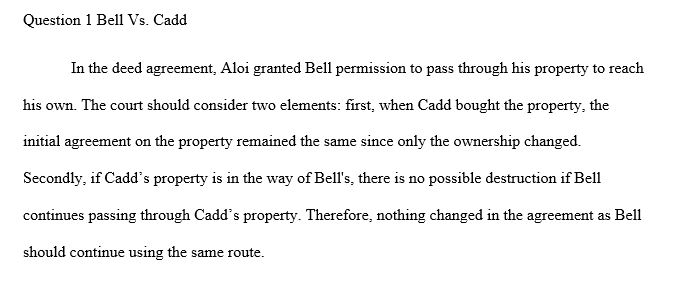Aloi sold a section of her land to Bell, including in the deed an easement allowing Bell to cross Aloi’s property to reach the newly
Each question requires no less than 5 sentences
1. Aloi sold a section of her land to Bell, including in the deed an easement allowing Bell to cross Aloi’s property to reach the newly acquired parcel. Three years later, Aloi sold his property to Cadd. Shortly thereafter, following an argument, Cadd put a chain across Bell’s right of way, saying that he had not given permission for Bell to cross his land. How should the court rule on this case and why?
3. When its lease expired, Kingston Frameworks made plans to move to another building. Preparations were made to remove shelving, mat and glass cutters, display boards, benches, and other fixtures that had been built into the store when the lease first started. All the shelves and fixtures were specially designed for the picture-framing business. The landlord told the owners of Kingston Frameworks to stop removing the items from the property. Could they remove the shelves and other fixtures that were paid for and installed by them during their tenancy? Why or why not? [See: George v. Town of Calais, 373 A.2d 553 (VT).]
1. Miguel Ruiz, who had a wife and two small children, did not have a will. A friend told Miguel that he should have a will because if he died without one, everything he owned would go to the state. Was the friend correct? Explain.
3. D. W. Elmer, a hospital patient, was seriously ill and unable to write his name. He executed his will, however, by making a belabored X on the paper in the presence of witnesses. Can a signature on a will made by an X be valid? Explain. [See: In re Estate of Elmer, 210 N.W.2d 815 (ND).]
1. While she was under investigation by a grand jury, Martha Stewart penned an e-mail that explained the circumstances that led to the ImClone scandal. Stewart then dispatched the e-mail to her attorney and sent a copy to her daughter, Alexis Stewart. The e-mail was inadvertently provided to the government, along with a number of other files that had been delivered in response to a subpoena. When the e-mail was identified, government attorneys went back to the court and asked the judge to decide whether they could use the e-mail as evidence. Stewart’s attorneys argued that the e-mail was under the protection of the attorney–client privilege and the work product privilege. On the other side of that argument, it is clear that the intended recipient of the e-mail was Stewart’s daughter, not her attorney. Should the judge uphold the protection granted by the attorney–client privilege and the work product privilege, or should she allow the government to use the e-mail, because Stewart sent it to a third party? Explain. [See: United States v. Stewart, 03 Cr. 717 (U.S. District Court Southern District of New York).]
Answer preview for Aloi sold a section of her land to Bell, including in the deed an easement allowing Bell to cross Aloi’s property to reach the newly

APA
411 Words